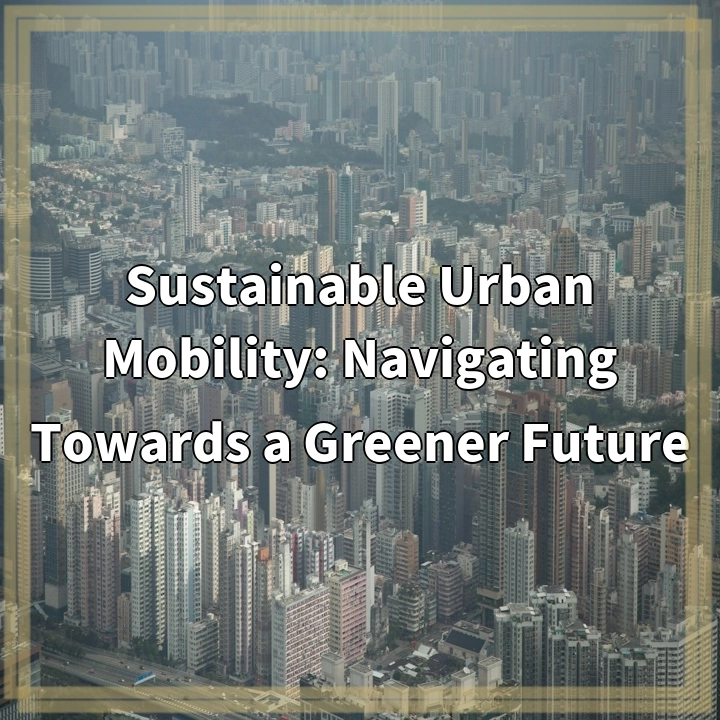
What is Sustainable Urban Mobility?
Sustainable urban mobility refers to the concept of planning and implementing transportation systems in urban areas that are efficient, environmentally friendly, and socially equitable. It involves promoting modes of transportation that reduce dependence on private vehicles, such as walking, cycling, using public transit, and adopting shared mobility options.
Real-World Problems Associated with Sustainable Urban Mobility
Traffic Congestion
One of the significant challenges in achieving sustainable urban mobility is traffic congestion. As cities grow, the number of vehicles on the roads increases, leading to gridlock, longer travel times, and increased greenhouse gas emissions. Congestion not only wastes time and energy but also has negative impacts on air quality and overall livability.
Pollution and Environmental Impact
Traditional forms of urban transportation, such as private cars and motorcycles, contribute to air and noise pollution, as well as carbon emissions. These pollutants have serious health consequences, leading to respiratory problems and other illnesses. By prioritizing sustainable urban mobility options, cities can dramatically reduce their carbon footprint and mitigate the adverse environmental impacts associated with transportation.
Unequal Access to Transportation
In many cities, access to transportation is not evenly distributed. Low-income communities and marginalized groups often face barriers to accessing affordable and reliable transportation options. This lack of access limits job opportunities, hinders social mobility, and exacerbates existing social and economic inequalities. Achieving sustainable urban mobility requires addressing these disparities and ensuring equal access for all residents.
Lack of Infrastructure and Planning
Insufficient investment in transportation infrastructure and poor urban planning can hinder the development and implementation of sustainable urban mobility solutions. Without adequate cycling lanes, pedestrian walkways, and public transit networks, it becomes challenging for residents to opt for greener modes of transportation. To overcome this problem, cities need to prioritize the construction of infrastructures that support sustainable mobility and integrate transportation planning with urban development plans.
Behavioral and Cultural Resistance
Changing deeply entrenched behaviors and attitudes towards transportation is another real-world problem facing sustainable urban mobility. Many individuals prefer the convenience and comfort of private cars, making it challenging to shift behaviors towards more sustainable modes of travel. Overcoming this resistance requires education, awareness campaigns, and providing incentives to encourage people to adopt greener transportation options.
By addressing these real-world problems and implementing innovative solutions, cities can navigate towards a greener future with sustainable urban mobility. It is essential to prioritize the development of infrastructure, create policies that promote alternative modes of transportation, and engage the community in the transition towards more sustainable mobility options.

Potential Solutions to Sustainable Urban Mobility Challenges
Addressing the real-world problems associated with sustainable urban mobility requires a combination of policy changes, infrastructure development, community engagement, and behavior change. Here are some potential solutions:
Investing in Public Transportation
One key solution is to prioritize and invest in the development of efficient, affordable, and reliable public transportation systems. This includes expanding bus and rail networks, improving frequency and connectivity, and integrating different modes of public transport. Accessible and efficient public transportation encourages people to leave their private vehicles at home and opt for greener options.
Promoting Active Modes of Transportation
Encouraging walking and cycling as primary modes of transportation can significantly reduce traffic congestion and carbon emissions while improving public health. Building proper pedestrian and cycling infrastructure, such as dedicated lanes and safe crossings, is crucial. Additionally, implementing bike-sharing programs and promoting active transportation through education and awareness campaigns can help shift behaviors towards these sustainable modes.
Implementing Car-Free Zones and Traffic Management Strategies
Designating car-free zones or pedestrian-only areas in city centers can create more livable and pedestrian-friendly spaces. These zones can encourage people to walk, shop, and socialize without the noise, pollution, and safety concerns associated with cars. Along with car-free zones, implementing traffic management strategies like congestion pricing and smart traffic control systems can help reduce traffic jams and incentivize alternative transportation methods.
Integrating Technology and Innovation
Leveraging technology and innovation can play a significant role in sustainable urban mobility. This includes implementing smart transportation systems that provide real-time information on public transportation schedules and availability. Embracing ridesharing and carpooling platforms can increase the efficient use of vehicles and reduce the number of cars on the road. Additionally, exploring alternative fuel sources such as electric or hydrogen-powered vehicles can help reduce pollution and dependence on fossil fuels.
Community Engagement and Education
Engaging the community in decision-making processes and raising awareness about the benefits of sustainable urban mobility is crucial. This can be done through educational campaigns, workshops, and public consultations. Involving residents in the planning and implementation of transportation projects can help ensure that their needs and concerns are heard and integrated into the overall strategy.
By implementing these solutions and fostering collaboration between stakeholders, cities can create a sustainable urban mobility system that promotes accessibility, reduces pollution, improves public health, and contributes to a greener future.















